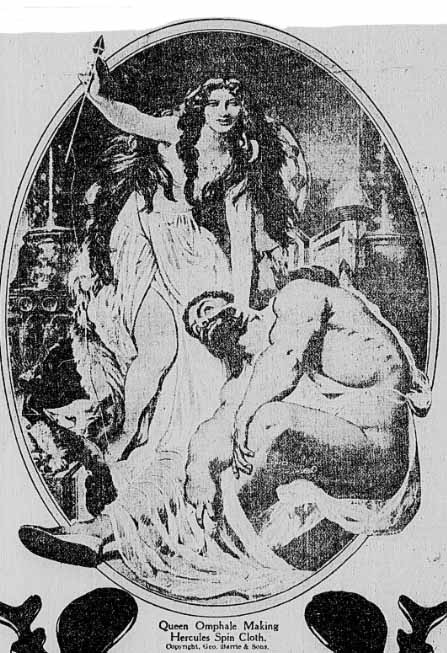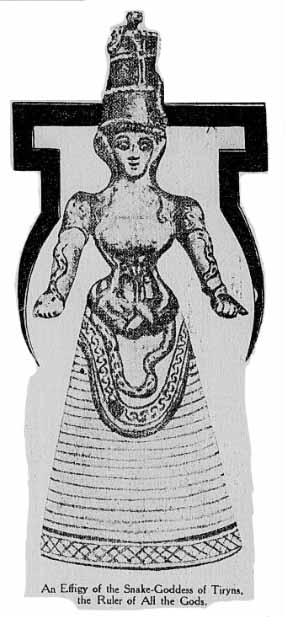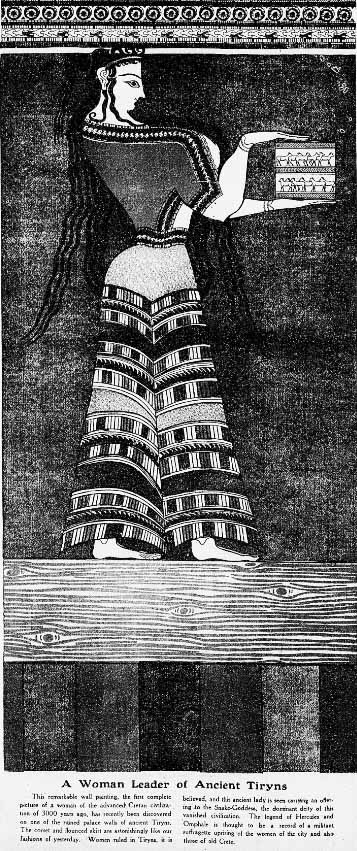
In the early 20th century, there were many attempts within newspapers to show that women once had power, such as the women of ancient Crete. The article below was published in 1913 and, what is really interesting about it is that it mentions both goddesses and Hercules as a crossdresser.

With the Corseted Suffragettes of 3000 Years Ago
The German society now digging among the ruins of the ancient civilization of Crete has just unearthed evidence of a successful militant suffragette movement at least 1200 years before our era, and probably 2000 years before it. The discoveries which lead the Germans to the conclusion that women on that distant date arose for their rights, and got them, were made at Tiryns, on the Greek mainland. Tiryns, in its heyday, was one of the greatest cities of the Cretans. It has been famous for centuries as the birthplace of Hercules, the greatest strong man and most vigorous demi-god of legend. Tiryns is now, and has been for centuries, a mass of ruins, mostly deep in earth. The sheep of the Greek shepherds have grazed above its palaces and temples for ages.
The conclusions of the scientists throw a strong new light on this legend of Hercules and his city. The famous story of his enslavement by Queen Omphale is only, they say, a fanciful presentation of the important fact that a great woman’s suffrage movement which swept over and conquered Crete began and was first successful in Tiryns. The method is one perfectly familiar to all students of legend and mythology.
The Cretan or Minoan language has never yet been read. No Rosetta stone, by which the hieroglyphics of the Egyptians were first deciphered, has been found to give the clue to the Minoan characters. But at Tiryns there was uncovered a mass of wonderful wall paintings, jars and vases and mosaics, most of which bore in pictures the story of this women’s uprising and its consequences so plainly that there can be little doubt that the German scientists have read their meaning rightly.

These were not Greeks who built Tiryns and who erected the magnificent palaces now being uncovered. The builders had come from Asia Minor, they were of the same old Minoan race as the Trojans. it was the might of the barbarian Greek city of Argos, a neighbor, which brought about the destruction of the Minoan cities, and with them Tiryns, about, perhaps, 500 B.C. The very ancient Greeks did not hold women in very high regard, and so they felt that it would never do to admit that woman had ever ruled, or there might be danger of the Greek women setting up their “rights” to dominate the State and society. Thus came about the peculiar twist in the Hercules legend which none has been able to explain hitherto.

It has been recognized as a Lydian part of the story, which means that it comes from Asia Minor, and this adds to the value of the new interpretation.
As the story goes, the hero Hercules is entrapped by Queen Omphale, and devotes himself to pleasures, losing himself in the society of women so far as to put on feminine attire, while his lively lady Omphale takes up his lion skin, puts it on, and with the club of Hercules in her hand flaunts herself before the degenerate hero, and proves herself the real hero.
Even though, according to the legend, Hercules does break forth from his effeminacy at times and vanquishes the Cecropes, the goblins who used to waylay travelers and slew Syleus, who compelled all travelers to dig in his vineyard, woman is still the dominating power. Queen Omphale has him completely at her mercy.

In the astonishing wall paintings at Tiryns the signs of the mastery of the women in all the religious rights first aroused the interest of the scientists. Upon one wall is a whole row of women bearing their offerings to the great patron goddess of the city and the sex – Juno, or Hera, as the Greeks called her. She was symbolized both in Tiryns and in Crete as the great snake goddess, the patroness of marriage and the ruler of men, for in her hand is always shown the scepter of dominance. Juno was known in later times even as Juno Regina, the Queen Goddess, a relic of the age in which the primeval woman of the older stock ruled all mankind, and she is always depicted with that prominent chin which betokens power and determination, and the high forehead, expressing great intellectual powers.
Source: The times dispatch. (Richmond, Va.), 18 May 1913.

